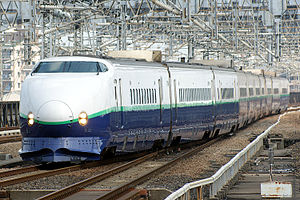200 Series Shinkansen
| 200 series | |
|---|---|

Refurbished 200 series trainset, July 2008
|
|
| In service | 1982–14 April 2013 |
| Manufacturer | Hitachi, Kawasaki Heavy Industries, Kinki Sharyo, Nippon Sharyo, Tokyu Car Corporation |
| Constructed | 1980–1986 |
| Refurbishment | 1999–2002 |
| Number built | 700 vehicles (66 sets) |
| Number in service | None |
| Number preserved | 6 vehicles |
| Formation | 8, 10, 12, 13, 16 cars |
| Operator(s) |
JNR (1982–1987) JR East (1987–2013) |
| Depot(s) | Niigata, Sendai |
| Line(s) served | Tōhoku Shinkansen, Jōetsu Shinkansen, Gala-Yuzawa Line |
| Specifications | |
| Car body construction | Aluminium |
| Car length | 25,000 mm (82 ft 0 in) |
| Width | 3,385 mm (11 ft 1.3 in) |
| Height | 4,410 mm (14 ft 6 in) |
| Doors | Two per side |
| Maximum speed | 240 km/h (149 mph) (275 km/h (171 mph) in past) |
| Traction system | Thyristor drive |
| Electric system(s) | 25 kV AC, 50 Hz, overhead catenary |
| Current collection method | Pantograph |
| Safety system(s) | ATC-2, DS-ATC |
| Multiple working | 400 series, E3 series |
| Track gauge | 1,435 mm (4 ft 8 1⁄2 in) |
The 200 series (200系?) was a Shinkansen high-speed train type introduced by Japanese National Railways (JNR) for the Tohoku Shinkansen and Joetsu Shinkansen high-speed rail lines in Japan, and operated by East Japan Railway Company (JR East) until 2013. They actually predated the 100 series trains, having been built between 1980 and 1986. It was one of the two recipients of the 23rd Laurel Prize presented by the Japan Railfan Club, the first Shinkansen type to receive that award. The last remaining sets were retired from regular service in March 2013, and were completely withdrawn from service in April 2013.
The 200 Series Shinkansen trains resembled the earlier 0 series trains in styling (some later units had the pointed 'shark nose' of the 100 series), but were lighter and more powerful, since these two lines are mountain routes and have steeper gradients. These lines are also prone to snowfall and the trains had small snowplows fitted, as well as protection of equipment against snow.
They were originally painted in ivory with a green window band and lower bodyside band, but a number of sets were refurbished and painted into a white-upper/dark blue-lower scheme with new wrap-around cab windows from 1999.
The first units were capable of 210 km/h (130 mph) but later ones can do 240 km/h (150 mph), and four were converted to be capable of 275 km/h (171 mph). Some units were also modified with retractable couplers in the nose for coupling with Yamagata Shinkansen Tsubasa and Akita Shinkansen Komachi Mini-shinkansen sets, but these are no longer in service. In addition, some of the later 200 series shinkansen trains were fitted with double-deck cars, which had semi-open standard-class compartments on the lower deck and green class (first class) seating on the upper deck. These too have been removed from service.
...
Wikipedia
